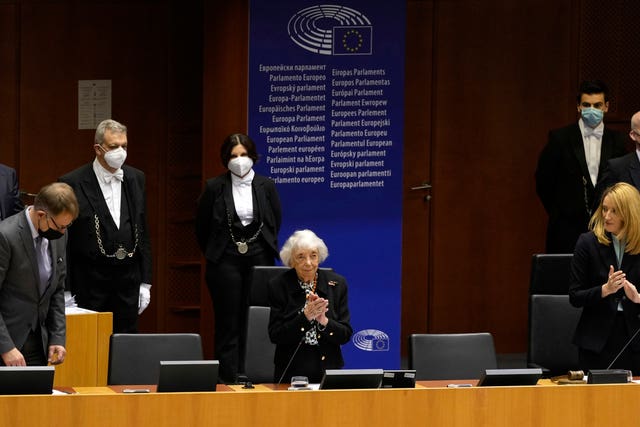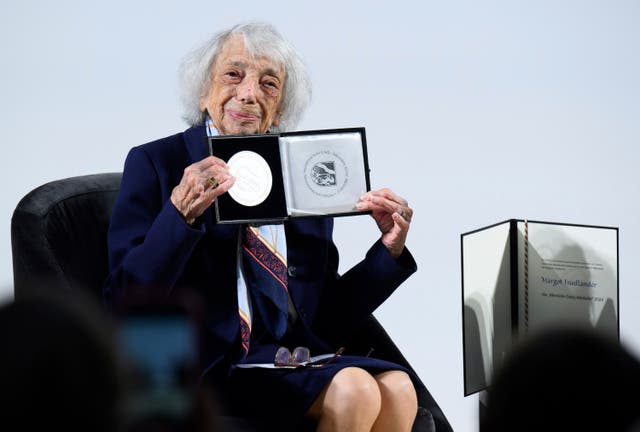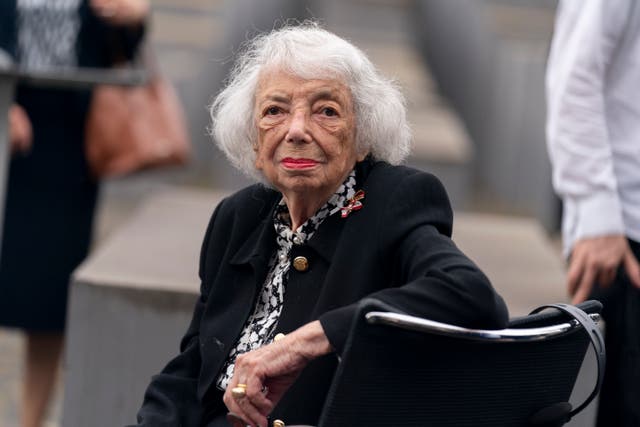German Holocaust survivor Margot Friedlander dies aged 103
She was honoured with Germany’s highest decoration and with a statue at Berlin’s City Hall.

Margot Friedlander, a German Jew who survived the Theresienstadt concentration camp and became a high-profile witness to Nazi persecution in her final years, has died aged 103.
Her death was announced by the Margot Friedlander Foundation in Berlin on its website.
Details about where she died, as well as the cause of death, were not immediately made public.

She died in the week of the 80th anniversary of Nazi Germany’s unconditional surrender in the Second World War.
After spending much of her life in the United States, Ms Friedlander returned to live in the German capital in her 80s.
She was honoured with Germany’s highest decoration and with a statue at Berlin’s City Hall.
“What I do gives me my strength and probably also my energy, because I speak for those who can no longer speak,” Ms Friedlander said at an event at Berlin’s Jewish Museum in 2018.
“I would like to say that I don’t just speak for the six million Jews who were killed, but for all the people who were killed – innocent people,” she said.
German President Frank-Walter Steinmeier expressed his condolences in a statement, saying she gave Germany reconciliation despite the horrors she went through there in her life.
Mr Steinmeier said the country cannot be grateful enough for her gift.
A report released last month said more than 200,000 Jewish survivors are still alive but 70% of them will be gone within the next 10 years.

Ms Friedlander was born Margot Bendheim on November 5 1921.
Her father, Artur Bendheim, owned a shop in Berlin.
He had fought for Germany and had been decorated in the First World War.
Ms Friedlander recalled that, after the Nazis took power, her father initially said that “they don’t mean us; We’re Germans”.
She added that “we didn’t see it until it was too late”.
Ms Friedlander wanted to design clothes and started an apprenticeship as a tailor.
After her parents divorced in 1937, Ms Friedlander, her mother and younger brother went to live with her grandparents.
In 1941, they had to move to a so-called “Jewish apartment”, and Ms Friedlander was forced to work nights at a metal factory.

In January 1943, just as the family was planning to flee Berlin, Ms Friedlander returned home to discover that her brother, Ralph, had been taken away by the Gestapo.
A neighbour told her that her mother had decided to go to the police and “go with Ralph, wherever that may be”.
She passed on her mother’s final message – “Try to make your life,” which would later become the title of Ms Friedlander’s autobiography – along with her handbag.
Ms Friedlander went into hiding, taking off the yellow star that Jews were obliged to wear.
She recalled getting her hair dyed red, reasoning that “people think Jews don’t have red hair”.
She said that 16 people helped keep her under the radar over the next 15 months.
That ended in April 1944 when she was taken in by police after being stopped for an identity check after leaving a bunker following an air raid.
She said she quickly decided to tell the truth and say that she was Jewish.
“The running and hiding was over,” she said.
“I felt separated from the fate of my people. I had felt guilty every day; had I gone with my mother and my brother, I would at least have known what had happened to them.”
Ms Friedlander arrived in June 1944 at the packed Theresienstadt camp.
In the spring of 1945, she recalled later, she saw the arrival of skeletal prisoners who had been forced on to death marches from Auschwitz ahead of that camp’s liberation.
“At that moment, we heard of the death camps, and at that moment I understood that I would not see my mother and my brother again,” she said.
Both were killed at the Auschwitz death camp.
Her father had fled in 1939 to Belgium.
He later went to France, where he was interned, before being deported in 1942 to Auschwitz, where he was also killed.
Shortly after the camp’s liberation, she married Adolf Friedlander, an acquaintance from Berlin whom she met again at Theresienstadt.

He had a sister in America, and – after months in a camp for displaced persons – they arrived in New York in 1946.
Ms Friedlander stayed away from Germany for 57 years.
She and her husband became US citizens; she worked as a tailor and later ran a travel agency.
Adolf Friedlander died in 1997, aged 87.
Margot returned to Germany for the first time in 2003, when she was received at Berlin’s City Hall along with others who had been pushed out by the Nazis.
In 2010, she moved back to the German capital, where she told her story to students and was decorated with, among other things, the country’s highest honour, the Order of Merit.
She was made a citizen of honour of Berlin in 2018.
Noting that there were few Holocaust survivors still alive, she told an audience that year: “I would like you to be the witnesses we can’t be for much longer.”





